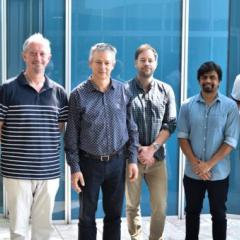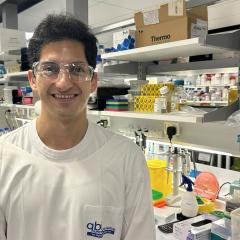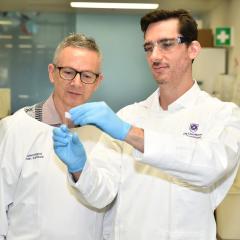With an increasing life expectancy, the number of Australians suffering from Alzheimer’s disease and related dementias, including frontotemporal dementia, is projected to dramatically increase from 460,000 currently to approximately 1.5 million by 2050.
The Götz laboratory, based at the Clem Jones Centre for Ageing Dementia Research (CJCADR), aims to understand Alzheimer's disease (AD) initiation and progression at a molecular and cellular level using cellular and animal models, and to develop novel therapies. Inevitably, we are applying the tools we are developing to also understand fundamental mechanisms of memory or the physiological role of proteins implicated in disease. In recent years, a major focus for the group has been in developing therapeutic ultrasound (with and without blood-brain barrier opening) into a treatment modality for human disease.
Group leader

Professor Jürgen Götz
Group Leader, Ageing dementia and therapeutic ultrasound
Director, Clem Jones Centre for Ageing Dementia Research
+61 7 334 66300
j.goetz@uq.edu.au
UQ Researcher Profile
@AustraliaGoetz
To develop a cure for Alzheimer’s disease and to develop a system that overcomes the blood-brain barrier as a major hurdle in drug delivery.
At the beginning of his career, Professor Jürgen Götz contributed mainly to developmental biology, moving his focus to neurodegenerative research in the early 1990s. Götz has been working in the therapeutic ultrasound space since 2014, with several major contributions to the field. In both the dementia and ultrasound space, Professor Götz is recognised as a key opinion leader reflected by several reviews in the Nature Reviews series.
Proving the amyloid cascade hypothesis in Alzheimer's disease (Science 2001)
In 2001, we experimentally provided proof for the central hypothesis of how the disease process is initiated in Alzheimer’s disease, a concept known as the 'amyloid cascade hypothesis'. This study is highly cited and has been listed as a landmark discovery on the Alzforum website.
Knowing what causes and drives Alzheimer’s disease provides a handle to ultimately combat a disease for which there is no cure.
A century earlier, Alois Alzheimer, in his landmark discovery, described amyloid plaques and tau tangles as the hallmark lesions of a disease that would eventually be named after him. However, how Aβ and tau interact has only gradually been revealed, and the amyloid cascade hypothesis was developed in the 1990s, placing Aβ upstream of tau in a pathocascade. In a breakthrough research achievement, Professor Götz showed that Aβ is indeed upstream of tau, causing the latter to aggregate into insoluble filaments. This major advance was made possible by using, for the first time, a combined transgenic and transplantation approach.
This advance was made possible by novel transgenic mouse models of Alzheimer’s disease, a research field Götz pioneered. He was the first to establish a tau transgenic mouse model to achieve a pre-tangle pathology. From here, Professor Götz established models with a more advanced pathology, which showed that tau aggregation can cause degeneration as evidenced, for example, by Wallerian degeneration. The identification of pathogenic mutations in the gene encoding tau in frontotemporal dementia then opened the field to the development of more robust tangle-forming experimental animal models. This work also resulted in two patented protocols of amyloid-β-mediated tau filament formation.
For amyloid to be toxic in Alzheimer’s brains it requires the protein Tau (Cell 2010)
The above work placed tau downstream of amyloid-β in the ‘amyloid cascade hypothesis’, but it was later revealed that the protein tau is by no means an innocent bystander. In a major development, Professor Götz and his team demonstrated that tau is, in fact, required for amyloid-β to exert its toxic effects on neurons. They were able to link the two key players via an enzyme called fyn and a receptor called NMDAR (which incidentally is antagonised by the Alzheimer’s drug Memantine).
The interactions which were revealed between NMDAR, tau and fyn offer avenues for therapeutic intervention. The team’s findings caused a major paradigm shift in the field and resulted in tau gaining attraction as a therapeutic target and the development of two patents.
Amyloid activates the production of tau protein, whereas Tau blocks the machinery which makes proteins (EMBO J 2017 & 2019)
Professor Götz and his team have a major interest in understanding what drives the accumulation of proteins in an aggregated form as this is the unifying feature of neurodegenerative disorders. They also have an interest in understanding where exactly in the cell these processes occur.
In a paradigm shift, the team identified a mechanism that involves local amyloid-β-mediated protein translation of tau in the cell body and in the dendrites (small processes), and interestingly, fyn - again - had a major role in this process. Not only did their data present a more cogent mechanism of tau aggregation in disease (than what was previously believed to be the mechanism), but they highlighted neuronal fyn as a drug target, given that this enzyme integrates signal transduction pathways, which lead to the somatodendritic accumulation of tau in Alzheimer's disease.
In a follow-up study, using innovative tools and techniques such as non-canonical amino acids and click chemistry, the team revealed that in primary tauopathies (frontotemporal dementia), different from Alzheimer’s disease, tau actually impairs new protein synthesis, in part because tau causes reduced levels of ribosomal proteins. This work is adding to an extensive body of work by Professor Götz and his team to understand how tau impairs neuronal functions (work ranging from exosomal release mechanisms to synaptic pruning and mitochondrial functions).
Scanning ultrasound is a noninvasive treatment modality for Alzheimer’s disease
(ScienceTranslMed 2015; Brain 2017; Theranostics 2018/2019, Alz Res Ther 2021, Mol Psych 2021)
In a major discovery, Professor Götz’s team developed a non-pharmacological approach for removing oligomeric and fibrillar forms of proteins such as amyloid-β and tau and restoring memory functions in transgenic mouse models. This was achieved by combining intravenously injected microbubbles with repeated scanning ultrasound (SUS) treatments of the brain, causing transient opening of the blood-brain barrier and the entering of blood-borne factors that (in the absence of any drug treatment) activated resident microglia. These internalised amyloid-β into their lysosomes. Amyloid plaque burden was massively reduced and SUSed mice displayed restored memory functions in three complementary tests. Given that repeated SUSing is non-invasive and caused no overt damage to brain tissue, Professor Götz’s study highlights its therapeutic potential for Alzheimer's disease, and possibly other diseases involving protein aggregation.
Professor Götz and his team then showed that SUS can also reduce an intraneuronal tau pathology (Brain 2017), by activating neuronal autophagy (Theranostics 2019). Importantly, SUS also facilitated a more than10-fold uptake of anti-tau antibody fragments not only by the brain but also by neurons. Similarly, the uptake of an Aducanumab analogue – an anti-amyloid- β drug - was greatly facilitated by SUS (AlzResTher 2021). Considering the high anticipated cost of potential Alzheimer’s vaccines (costs for Aducanumab may be in the order of 60,000 US$ per patient per year), this study highlights the possibility of facilitating brain uptake of therapeutic antibodies and thereby reducing costs significantly.
In translating rodent studies to the human brain, the presence of a thick cancellous skull that both absorbs and distorts ultrasound presents a challenge. Götz and his team established sheep as a larger animal model that is more similar to humans, demonstrating safe blood-brain barrier opening (Theranostics 2018). Moreover, the team showed, that SUS with and without microbubbles (i.e. with and without openeing of the blood-brain barrier) can restore the induction of long-term potentiation (LTP), an electrophysiological correlate of memory, as well as spatial memory (MolPsych 2021) indicating the general suitability of the technology for restoring cognition.
Currently, Professor Götz and his team are working together with engineers, clinicians, a CRO, and a commercialisation team to develop a medical device, conduct clinical trials and establish an ultrasound-based ecosystem.
- Understanding the role of exosomes in tau spreading
- Developing and improving Tau antibodies and understanding their mode of action in the presence and absence of low-intensity ultrasound
- Understanding blood-brain barrier opening and closing in response to therapeutic ultrasound at a cellular and molecular level
- Using super resolution microscopy to understand synaptic dysfunction in Alzheimer’s disease
- Using super resolution microscopy to understand blood-brain barrier (BBB) opening in response to therapeutic ultrasound
- Deciphering the role of glial Tyrobp in development and disease
- Understanding new protein synthesis in glia using click chemistry
- Developing novel Alzheimer’s mouse models using CRISPR gene editing technology
- Developing therapeutic ultrasound into a therapy for Alzheimer’s disease
- Understanding how low-intensity ultrasound can be used as a neuromodulatory tool (exerting radiation forces rather than blood-brain barrier (BBB) opening)
- Using click chemistry to reveal how neurons and glia shape perineuronal nets
- Restoring plasticity and cognitive functions in Alzheimer’s disease
Publications
(as of April, 2023)
- 220+ peer-reviewed articles (3 Cell, 1 Science, 1 Science Transl Med, 3 Neuron, 8 PNAS, 9 EMBO J, 7 J. Biol. Chem., 3 Mol Psych, 5 Acta Neuropathol, 1 Lancet, 4 Nature Rev Neurosci, 3 Nature Rev Neurol, 1 Nature Rev Drug Disc, 3 Nature Prot, 5 Theranostics)
- Web of Science highly cited papers in the fields of Neuroscience & Behavior (5), Biology & Biochemistry, Pharmacology & Toxicology, and Molecular Biology & Genetics
- 27,700 citations (Google Scholar)
- Total Impact factor: 2,000
- h-index: 86 (78 papers, >100 cit) (Google Scholar)
- Expertscape ranking (Top 0.02% of 182, 647 published authors worldwide in Alzheimer's Disease)
- Highly cited researcher 2022 (Clarivate)
Book chapters and other contributions
11. Götz J (2020) Ultrasound-mediated Alzheimer’s therapy, Referat Neurologie, Jatros Neurologie & Psychiatrie 4/2020, p. 6-8
10. Leinenga G, Götz J (2019) Book chapter in the Research 'Topic Brain Protein Aging and Dementia Control': (ed. Naruhiko Sahara, Gen Sobue) Safety and efficacy of scanning ultrasound treatment of aged APP23 mice
9. Leinenga G, Götz J (2017) Book chapter: Brain Circuitry and Neuromodulation: From Research to Clinical Practice (ed. Nir Lipsman and Tejas Sankar) Section 'Techniques of Neuromodulation Chapter' on 'Focused Ultrasound' (invited contribution)
8. Götz J, Büttner S (2011) Stem cell therapy in Alzheimer’s disease models: neurogenesis versus trophic support, in: Frontiers in pluripotent stem cells research and therapeutic potentials. Bench-to-Bedside, Ed. K Sidhu (Bentham Books), Chapter 15, pp. 220-226
7. Götz J, Schonrock N, Vissel B, Ittner LM (2010) Alzheimer’s disease selective vulnerability and modelling in transgenic mice, in J Alzheimers Dis Handbook ‘Animal Models of Alzheimer’s Disease’, IOS Press, pp. 49-58
6. Götz J, Ittner LM, Götz NN, Lam H, Nicholas H (2011) RSC (The Royal Society of Chemistry) Drug Discovery Series, Animal Models for Neurodegenerative Disease, ‘Invertebrate and vertebrate models of tauopathies’, Edited by Jesús Avila, Jose J Lucas and Félix Hernández (ISBN-10: 1849731845), Chapter 5, pp. 69-85
5. Götz J, David DC, Ittner L (2007) Impact of β-amyloid on the tau pathology in tau transgenic mouse and tissue culture models (chapter 12/16). In: Celebrating a Century of Research. Abeta Peptide and Alzheimer’s Disease (editors: Colin C. Barrow and David H. Small, Springer-Verlag London Ltd.), Chapter 12, pp. 198-215
4. Götz J, Chen F (2006) Glyoxalase I and Alzheimer’s disease. In: Research Progress in Alzheimer’s Disease and Dementia (editor: M.-K. Sun; Nova Science Publishers, Inc., New York), ISBN 1-59454-949-4, Chapter 10, pp. 191-204
3. Chen F, Ferrari A, Schild A, Kurosinski P, David D, Hoerndli F, Pennanen L, Kins S, van Dorpe J, Nitsch RM, Götz J (2003) Amyloid-induced neurofibrillary tangle formation. In: Alzheimer’s disease and related disorders: Research advances (editors: K. Iqbal, B. Winblad; Ana Aslan International Foundation), chapter 30, pp. 343-354
2. Götz J (2002) Die Alzheimer’sche Krankheit: Wechselwirkung zwischen Tau und β-Amyloid, Festschrift aus Anlass der Verleihung des Georg Friedrich Götz-Preises 2002, pp. 1-17
1. Goedert M, Spillantini MG, Jakes R, Crowther RA, Cohen P, Vanmechelen E, Probst A, Götz J, Bürki K (1995) Molecular dissection of the paired helical filament. In: Recent Advances in Alzheimer's Disease and Related Disorders (K.Iqbal, J.Mortimer, B.Winblad & H.Wisniewski,eds). Wiley and Sons, Chapter 54, pp. 493-502
Refereed journal articles
222. Blackmore, Daniel G., Razansky, Daniel and Götz, Jürgen (2023). Ultrasound as a versatile tool for short- and long-term improvement and monitoring of brain function. Neuron, 111 (8), 1174-1190. [IF 18.69]
221. Taylor, Deonne, Kneynsberg, Andrew, van Roijen, Marloes and Götz, Jürgen (2023). Tyrosine phosphatase STEP61 in human dementia and in animal models with amyloid and tau pathology. Molecular Brain, 16 (1) 6, 6. [IF 4.902]
220. Polanco, Juan Carlos, Akimov, Yevhen, Fernandes, Avinash, Briner, Adam, Hand, Gabriel Rhys, van Roijen, Marloes, Balistreri, Giuseppe and Götz, Jürgen (2022). CRISPRi screening reveals regulators of tau pathology shared between exosomal and vesicle-free tau. Life Science Alliance, 6 (1), e202201689. [IF 5.781]
219. Martínez-Mármol, Ramón, Small, Christopher, Jiang, Anmin, Palliyaguru, Tishila, Wallis, Tristan P., Gormal, Rachel S., Sibarita, Jean-Baptiste, Götz, Jürgen and Meunier, Frédéric A. (2022). Fyn nanoclustering requires switching to an open conformation and is enhanced by FTLD-Tau biomolecular condensates. Molecular Psychiatry, 28 (2), 1-17. [IF 13.44]
218. Chen, Liyu, Cruz, Esteban, Oikari, Lotta E., Padmanabhan, Pranesh, Song, Jae and Götz, Jürgen (2022). Opportunities and challenges in delivering biologics for Alzheimer's disease by low-intensity ultrasound. Advanced Drug Delivery Reviews, 189 114517, 114517. [IF 15.47]
217. Bajracharya, Rinie, Cruz, Esteban, Götz, Jürgen and Nisbet, Rebecca M. (2022). Ultrasound-mediated delivery of novel tau-specific monoclonal antibody enhances brain uptake but not therapeutic efficacy. Journal of Controlled Release, 349, 634-648. [IF 11.47]
216. Padmanabhan, Pranesh, Kneynsberg, Andrew, Cruz, Esteban, Amor, Rumelo, Sibarita, Jean‐Baptiste and Götz, Jürgen (2022). Single‐molecule imaging reveals Tau trapping at nanometer‐sized dynamic hot spots near the plasma membrane that persists after microtubule perturbation and cholesterol depletion. The EMBO Journal, 41 (19) e111265, 1-16. [IF 13.78]
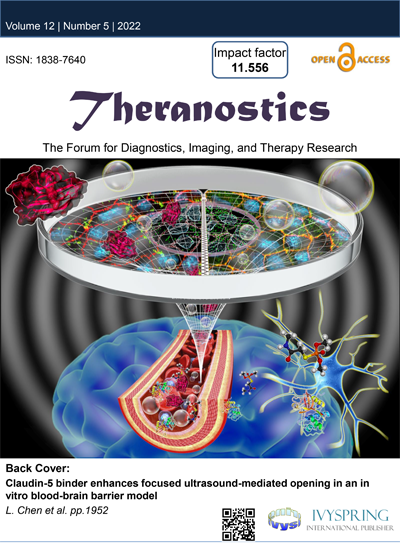
215. Leinenga G, Bodea L-G, Schröder J, Sun GZ, Zhou Y, Song J, Grubman A, Polo JM*, Götz J* (2022) Disrupting the blood-brain barrier with scanning ultrasound leads to microglial activation and proliferation, Bioengineering & Translational Medicine (*shared author) (acc, April 5, 2022) [IF 10.711]
214. Milner MT, Lawrence G, Holley CL, Bodea L-G, Götz J, Burgener SS, Schroder K (2022) Isolation and culture of pure adult microglia and astrocytes for in vitro characterisation and analyses, STAR Protocols, 3:101295 [IF N.A.]
213. Chen L, Sutharsan E, Lee JLF, Cruz E, Asnicar B, Palliyaguru T, Wasielewska JM, Gaudin A, Song J, Leinenga G, Götz J (2022) Claudin-5 binder enhances focused ultrasound-mediated opening in an in vitro blood-brain barrier model, Theranostics 12(5):1952-1970 [Back Cover image] [IF 11.556] (1 cit.)
212. Padmanabhan P, Kneynsberg A, Götz J (2021) Super-resolution microscopy: A closer look at Alzheimer disease, Nature Rev Neurosci 22: 723-740 [IF 33.162] (4 cit.)
211. Götz J, Richter-Stretton G, Cruz E (2021) (ed. Antonis Pouliopoulos, Contribution to Special Issue on “Ultrasound-Mediated Delivery of Nanopharmaceuticals”) Pharmaceutics 13:1002 [IF 6.734] (1 cit.)
210. Polanco JC, Götz J (2021) Propagation of exosomal and vesicle-free tau seeds, and the role of endolysosomal permeabilization, FEBS Letters (doi: 10.1111/febs.16055. Online ahead of print) [IF 3.057] (7 cit.)
209. Evans HT, Taylor D, Kneynsberg A, Bodea L, Götz J (2021) Tau causes altered ribosomal function and protein synthesis in vitro, Acta Neuropathol Commun 9:1-14 [IF 7.801] (4 cit.)
208. Ahier A, Cummins N, Dai CY, Götz J, Zuryn S (2021) PINK1 and parkin shape the organism-wide distribution of a deleterious mitochondrial genome, Cell Reports 35:109203 [Cover image] [IF 8.109] (10 cit.)
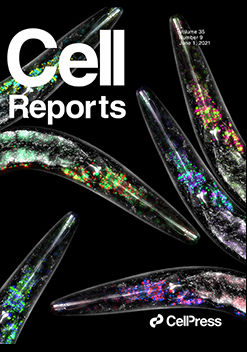
207. Blackmore DG, Turpin F, Palliyaguru T, Evans HT, Chicoteau A, Lee W, Pelekanos M, Nguyen N, Song J, Sullivan RKP, Sah P, Bartlett PF, Götz J (2021) Low-intensity ultrasound restores long-term potentiation and memory in aged mice through pleiotropic mechanisms including NMDAR signaling, Mol Psych 26:6975-6991 [Featured on AlzForum: https://www.alzforum.org/news/research-news/no-breach-needed-ultrasound-improves-memory-mice] [IF 15.990] (9 cit.)
206. Leinenga G, Koh WK, Götz J (2021) A comparative study of the effects of Aducanumab and scanning ultrasound on amyloid plaques and behavior in the APP23 mouse model of Alzheimer disease, Alz Res Ther 13: 1-14 [IF 6.104] (17 cit.)
205. Bajracharya R, Brici D, Bodea L, Janowicz P, Jones M, Götz J*, Nisbet RM* (2021) Tau antibody isotype induces differential effects following passive immunisation of tau transgenic mice, Acta Neuropathol Commun 9:1-13 (*shared authorship) [IF 7.801] (6 cit.)
204. Evans HT, Blackmore D, Götz J*, Bodea L* (2021) De novo proteomic methods for examining the molecular mechanisms underpinning long-term memory, (in: 'Novel Memory Mechanisms' (ed. Peter Giese)), (*shared authorship) Brain Res Bull 169: 94-103 [IF 3.103] (2 cit.)
203. Polanco JC, Briner A, Li C, Hand GR, Götz J (2021) Exosomes induce lysosome-mediated permeabilization of endosomes during induction of tau aggregation, Acta Neuropathol 141:235-256 [Cover image] [Featured on AlzForum: https://www.alzforum.org/news/research-news/do-lysosomes-help-propagate-tau-seeds] [IF 18.174] (27 cit.)
202. Milner MT, Maddugoda M, Götz J, Burgener SS, Schroder K. (2021) The NLRP3 inflammasome triggers sterile neuroinflammation and Alzheimer’s disease, Curr Opin Immunol 68:116-124 [IF 7.580] (24 cit.)
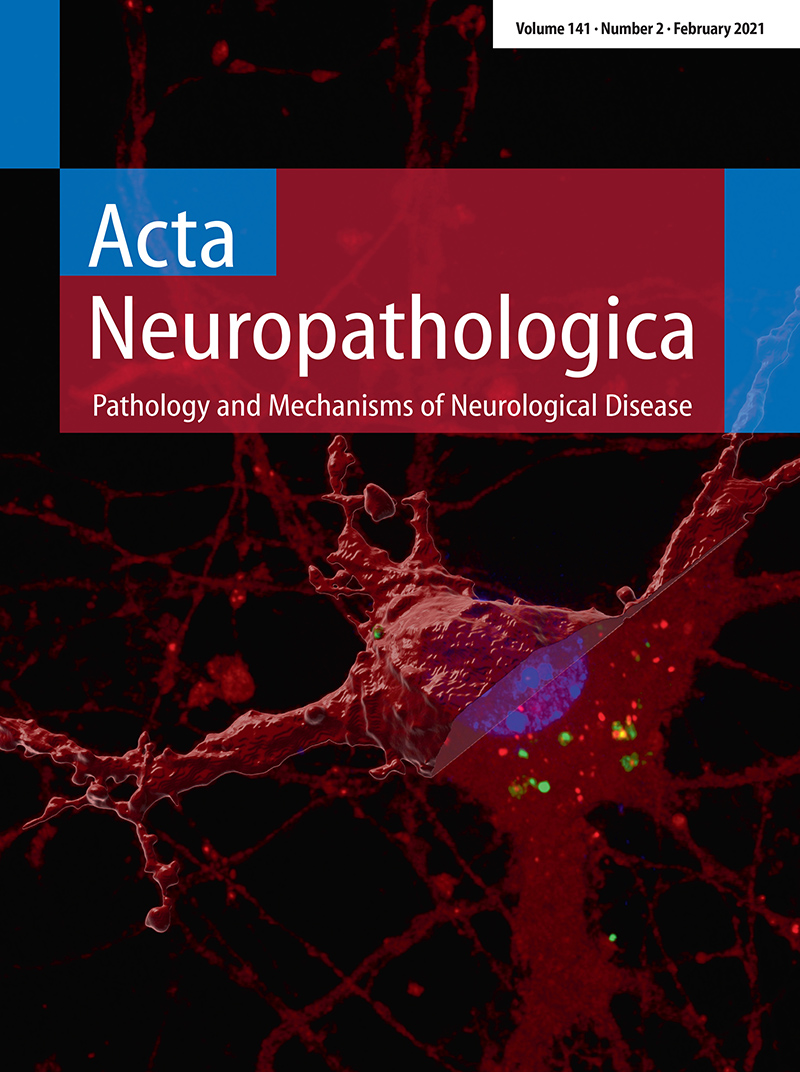
201. Pandit R, Koh WK, Sullivan RKP, Palliyaguru T, Parton RG, Götz J (2020) Role for caveolin-mediated transcytosis in facilitating transport of large cargoes into the brain via ultrasound, J Contr Release 327: 667-675 [Back cover image] [IF 9.776] (15 cit.)
200. Briner A, Götz J, Polanco JC (#) (2020) Fyn kinase controls tau aggregation in vivo, Cell Reports 32(7): 108045 (#, postdoc in JG's lab) [Cover image] [IF 8.109] (27 cit.)
199. Leinenga G, Bodea L, Koh WK, Nisbet RM, Götz J (2020), Delivery of Antibodies into the Brain Using Focused Scanning Ultrasound, JOVE 2020 Jul 18;(161). doi: 10.3791/61372 [IF 1,324] (6 cit.)
198. Benetatos J, Bennett RE, Evans HT, Ellis SA, Hyman BT, Bodea L, Götz J (2020) PTEN Activation Contributes to Neuronal and Synaptic Engulfment by Microglia in Tauopathy, Acta Neuropathol. 140: 7-24 [IF 18.174] (14 cit.)
197. Oikari LE, Pandit R, Cuní-López C, Rantanen LM, Quek H, Lehtonen S, de Boer S, Polo JM, Götz J, Koistinaho J, White AR (2020) Brain endothelial cells carrying familial Alzheimer’s mutations exhibit an altered phenotype and sustained permeability in response to focused ultrasound, with potential implications for amyloid clearance and drug delivery, Stem Cell Reports, 14(5): 924-939 [IF 6.537] (29 cit.)
196. Evans HT, Bodea L, Götz J (2020) Cell-specific non-canonical amino acid labelling identifies changes in the de novo proteome during memory formation, eLife 9:e52990 [IF 7.616] (14 cit.)
195. Pandit R, Chen L, Götz J (2020) - The blood-brain barrier: physiology and strategies for drug delivery, ADDR Editor's Collection 2019, Adv Drug Del Rev, 165-166: 1-14 [IF 15.606] (112 cit.)
194. Götz JJ, Götz J (2019) Experimental Models of Tauopathy - From Mechanisms to Therapies (Tau Biology), Adv Exp Med Biol. 1184: 381-391 [IF 2.126] (8 cit.)
193. Grimm A, Lejri I, Hallé F, Schmitt M, Götz J, Bihel F, Eckert A (2020) Mitochondria modulatory effects of new TSPO ligands in a cellular model of tauopathies, J Neuroendocrinol 32(1):e12796 [IF 3.040] (14 cit.)
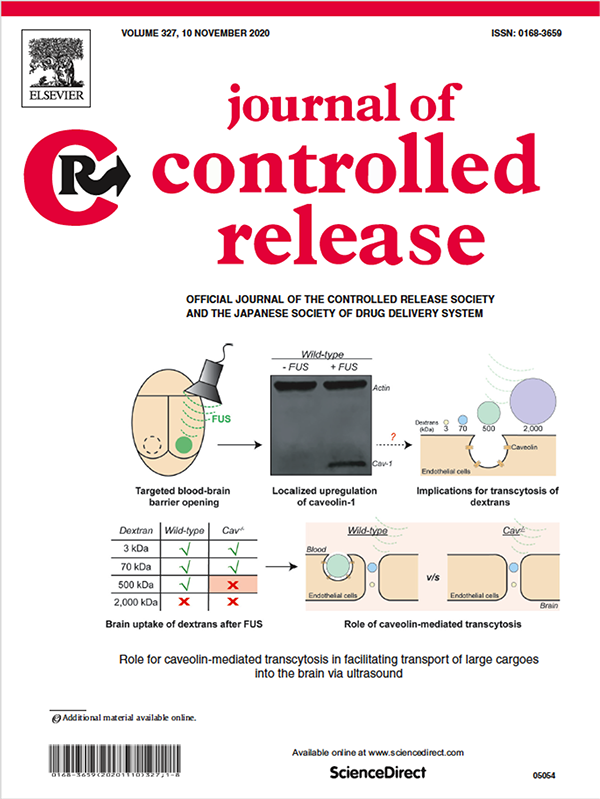
192. Leinenga G, Koh WK, Götz J (2019) Scanning ultrasound in the absence of blood-brain barrier opening is not sufficient to clear b-amyloid in the APP23 mouse model of Alzheimer's disease, Brain Res Bull, 153: 8-14 [IF 3.440] (12 cit.)
191. Padmanabhan P, Martinez-Marmol R, Xia D, Goodhill G, Götz J#, Meunier FA# (2019) Frontotemporal dementia mutant Tau promotes aberrant Fyn nanoclustering in dendritic spines (#equal contribution), eLife, pii: e45040. doi: 10.7554/eLife.45040 [IF 7.616] (21 cit.)
190. Janowicz P, Leinenga G, Götz J#, Nisbet R# ($) (2019) Ultrasound-mediated blood-brain barrier opening enhances delivery of therapeutically relevant formats of a tau-specific antibody, Sci Rep, 9: 9255 (#equal contribution) ($, postdoc in JG's lab) [IF 4.122] (41 cit.)
189. Li C, Briner A, Götz J (2019) The search for improved animal models of Alzheimer's disease and novel strategies for therapeutic intervention, Future Med Chem, 11: 1853-1857 [IF 3.969] (4 cit.)
188. Pandit R, Leinenga G, Götz J (2019) Repeated ultrasound treatment improves motor function and clears neuronal tau by autophagy, Theranostics, 9(13): 3754-3767 [IF 11.556] (52 cit.)
187. Evans HT, Benetatos J, van Roijen M, Bodea L, Götz J (2019) Decreased synthesis of ribosomal proteins in tauopathy revealed by non-canonical amino acid labelling, EMBO J, 38(13):e101174 [Cover image] [IF 11.600] (41 cit.)
186. Mohamed AZ, Cumming P, Götz J, Nasrallah F (2019) Tauopathy in veterans with long-term posttraumatic stress disorder and traumatic brain injury, Eur J Nucl Med Mol Imaging 46: 1139-1151 [IF 7.277] (29 cit.)
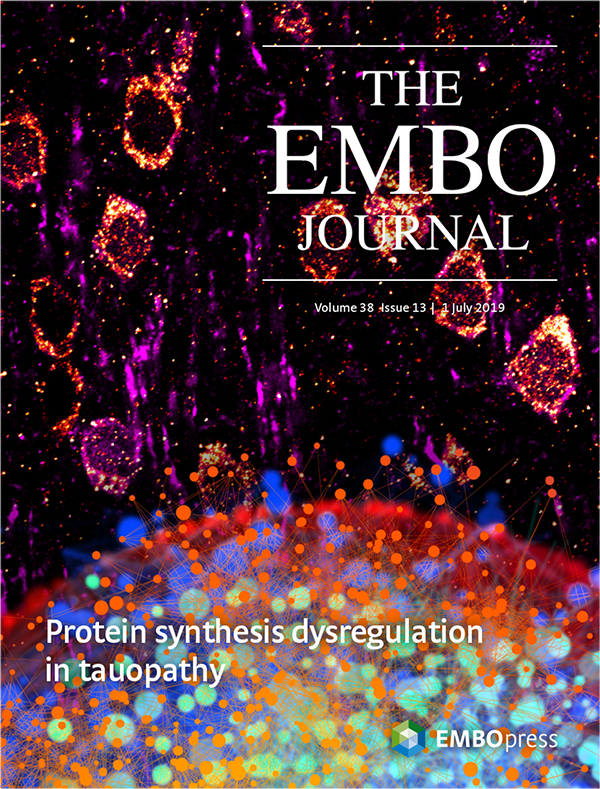
185. Götz J, Halliday G, Nisbet R (2019) Molecular Pathogenesis of the Tauopathies, Annual Review Pathol Dis Mech 14: 239-261 [IF 23.758] (100 cit.)
184. Cummins N, Tweedie A, Zuryn S, Bertran-Gonzalez J, Götz J (2019) Disease-associated tau impairs mitophagy by inhibiting Parkin translocation to mitochondria, EMBO J 38(3). pii: e99360 [Featured on AlzForum: https://www.alzforum.org/news/research-news/could-disposing-damaged-mitochondria-treat-alzheimers-disease] [IF 11.600] (117 cit.)
183. Blackmore D, Turpin F, Mohamed AZ, Zong F, Pandit R, Pelekanos M, Nasrallah F, Sah P, Bartlett P, Götz J (2018) Multimodal analysis of aged wild-type mice exposed to repeated scanning ultrasound treatments demonstrates long-term safety, Theranostics 8(22): 6233-6237 [highlighted in Editorial: Toccaceli et al., Theranostics 2019; 9(2): 537-539, Low-intensity focused ultrasound for the treatment of brain diseases: safety and feasibility] [IF 11.556] (25 cit.)
182. Polanco JC & Götz J (2018) Are you TORCing tau me? - amyloid-β blocks the conversation between lysosomes and mitochondria (News & Views), EMBO J 15:37 [IF 11.600] (4 cit.)
181. Grimm A, Cummins N, Götz J (2018) Local oxidative damage in the soma and dendrites results in quarantining of mitochondria, iScience (Cell Press) 6: 114-127 [IF N.A.] (11 cit.)
180. Odabaee M, Odabaee M, Pelekanos M, Leinenga G, Götz J (2018) Modeling ultrasound propagation through material of increasing geometrical complexity, Ultrasonics 90: 52-62 [IF 2.327] (9 cit.)
179. Götz J , Bodea L, Goedert M (2018) Rodent models for Alzheimer's disease, Nature Rev Neurosci, 19: 583-598 [IF 31.376] (172 cit.)
178. Li C, Götz J (2018) Pyk2 is a novel tau tyrosine kinase regulated by the tyrosine kinase Fyn, J Alzheimers Dis 64: 205-221 [Featured article on JAD website] [IF 3.920] (34 cit.)
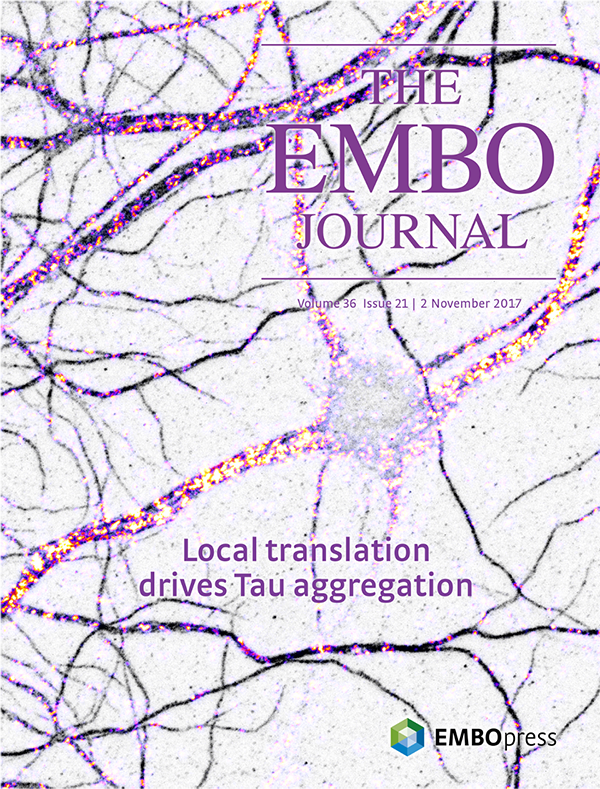
177. Pelekanos M, Leinenga G, Odabaee M, Saifzadeh S, Steck R, Götz J (2018) Establishing sheep as an experimental species to validate ultrasound-mediated blood-brain barrier opening for potential therapeutic interventions, Theranostics 8: 2583-2602 [IF 11.556] (24 cit.)
176. Polanco JC, Li C, Durisic N, Sullivan R, Götz J (2018) Exosomes hijack the endosomal pathway to spread through interconnected neurons, Acta Neuropathol Commun. 6:10 [IF 7.801] (110 cit.)
175. Leinenga G, Götz J (2018) Safety and efficacy of scanning ultrasound treatment of aged APP23 mice, Front Neurosci.12:55 [IF 3.566] (41 cit.)
174. Brici D, Götz J, Nisbet R (#) (2018) A novel antibody targeting tau phosphorylated at serine 235 detects neurofibrillary tangles, J Alzheimers Dis 61(3): 899-905 (#, postdoc in JG's lab) [RN235 antibody made commercially available through Merck] [IF 3.920] (12 cit.)
173. Nisbet R, Götz J (2018) Amyloid-β and tau in Alzheimer's disease - novel pathomechanisms and non-pharmacological combinatorial treatment strategies, J Alzheimers Dis 64: S517-527 [IF 3.920] (26 cit.)
172. Polanco JC, Li C, Bodea L-G, Martinez-Marmol R, Meunier F, Götz J (2018) Amyloid-β and tau complexity: towards improved biomarkers and targeted therapies, Nature Rev Neurol, 14(1): 22-39 [IF 20.257] (261 cit.)
171. Matamales M, Skrbis Z, Bailey MR, Balsam PD, Balleine BW, Götz J, Bertran-Gonzalez J (#) (2017) Corticostriatal stiffness promotes action swiftness in advanced aging, eLife, Oct 23;6. pii: e29908. doi: 10.7554/eLife.29908 (#, postdoc in JG's lab) [IF 7.725] (9 cit.)
170. Cummins N, Götz J (2017) Shedding light onto mitophagy in neurons: what is the evidence for PINK1/Parkin mitophagy in vivo?, Cell Mol Life Sci 75: 1151-1162 [IF 6.07] (44 cit.)
169. Forrest SL, Kril JJ, Stevens CH, Kwok JB, Hallupp M, Kim W, Huang Y, McGinley CV, Werka H, Kiernan MC, Götz J, Spillantini MG, Hodges JR, Ittner LM, Halliday GM (2018) Retiring the term FTDP-17 as MAPT mutations are genetic forms of sporadic frontotemporal tauopathies, Brain 141: 521-534 [IF 13.500] (108 cit.)
168. Li C, Götz J (2017a) Somatodendritic accumulation of Tau in Alzheimer's disease is promoted by Fyn-mediated translation, EMBO J 36 (21): 3120-3138 [Cover image][Commented on work prior to publishing: http://www.alzforum.org/news/conference-coverage/new-explanation-dendritic-tau-its-made-there][Recommended in F1000Prime as being of special significance in its field] [IF 11.600] (130 cit.)

167. Li C, Götz J (2017b) Tau-based therapies in neurodegeneration – opportunities and challenges, Nature Rev Drug Disc 16: 863-883 [Featured article][Cover image] [IF 57.000] (172 cit.)
166. Amar F, Sherman MA, Rush TJ, Larson M, Boyle G, Chang L, Götz J, Buisson A, Lesné SE (2017) The amyloid-β oligomer Aβ*56 induces specific alterations in neuronal signaling that lead to tau phosphorylation and aggregation, Science Signaling 10: 478 [IF 6.279] (79 cit.)
165. Nisbet R, van der Jeugd A, Leinenga G, Evans HT, Janowicz PW, Götz J (2017) Combined effects of scanning ultrasound and a tau-specific single chain antibody in a tau transgenic mouse model, Brain 140(5): 161-74 [recommended in F1000Prime][IF 13.500] (126 cit.)
164. Leinenga G, Nisbet R, Götz J (2017) Perspective: Ultrasound as a treatment modality in neurodegenerative diseases, Med J Aust 206:470-471 [IF 6.112] (1 cit.)
163. Hatch R, Wei Y, Xia D, Götz J (2017) Hyperphosphorylated tau causes reduced hippocampal CA1 excitability by relocating the axon initial segment, Acta Neuropathol 133: 717-730 [IF 15.872] (86 cit.)
162. Ahmed RM, Muireann I, van Eersel J, Ke YD, Voelkerling A, van der Hoven J, Tanaka K, Karl T, Krill JK, Piguet O, Götz J, Kiernan MC, Halliday GM, Hodges JR, Ittner LM (2017) Mouse models of frontotemporal dementia: improving the understanding of these models by using an approach based on clinical symptoms, Neurosci & Biobeh Reviews 74: 126-138 [IF 8.802] (19 cit.)
161. Bodea L-G, van der Jeugd A, Evans HT, Ittner LM, Delerue F, Kril J, Halliday G, Hodges J, Kiernan MC, Götz J (2017) Accelerated aging exacerbates the pre-existing pathology in a tau transgenic mouse model, Aging Cell 16: 377-386 [IF 6.714] (29 cit.)
160. Hatch R, Leinenga G, Götz J (2016) Scanning Ultrasound (SUS) causes no changes to neuronal excitability and prevents age-related reductions in hippocampal CA1 dendritic structure in wild-type mice, PLoS One 11 (10):e0164278 [IF 3.234] (27 cit.)
159. Brandt R, Götz J (2016) Editorial for Special Issue on 'Cytoskeletal proteins in health and neurodegenerative disease' (9 articles, page 213-353), Brain Res Bull 126: 213-216 [IF 3.400] (5 cit.)
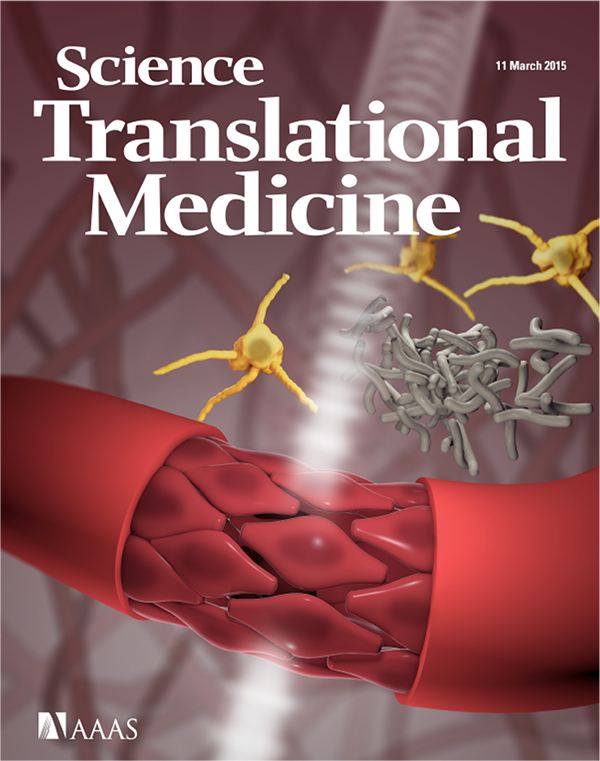
158. Jiao SS, Shen LL, Zhu C, Bu XL, Liu YH, Liu CH, Yao XQ, Zhang LL, Zhou HD, Walker DG, Tan J, Götz J, Zhou X-F, Wang Y-J (2016) Brain-derived neurotrophic factor protects against neurodegeneration in a mouse model of human tauopathy, Transl Psych 6 (10):e907 [IF 5.620] (132 cit.)
157. Chai Ye Jin, Sierecki E, Tomatis VM, Gormal RS, Ariotti N, Giles N, Xia D, Götz J, Parton R, Collins BM, Gambin Y, Meunier FA (2016) Munc18-1 is a molecular chaperone for a-synuclein controlling its self-replicating aggregation, J Cell Biol 214 (6): 705-718 [IF 10.539] (48 cit.)
156. Baker S, Polanco JC, Götz J (2016) Extracellular vesicles containing transgenic tau accelerate tau pathology in ALZ17 mice but do not seed mature neurofibrillary tangles, J Alzheimers Dis 54(3): 1207-1217 [IF 3.731] (54 cit.)
155. Xia D, Gutmann JM, Götz J (2016) Mobility and subcellular localization of endogenous, gene-edited Tau differs from that of over-expressed human wild-type and P301L mutant Tau, Scientific Reports 6:29074 [IF 5.578] (34 cit.)
154. Matamales M, Götz J, Bertran-Gonzalez J (#) (2016) Quantitative imaging of cholinergic interneurons reveals a distinctive spatial organization and a functional gradient of activity across the mouse striatum, PLoS One 11(6): e0157682 (#, postdoc in JG's lab) [IF 3.534] (29 cit.)
153. Anggono V, Tsai L-H, Götz J (2016) Editorial: Glutamate receptors in Alzheimer’s disease: Mechanisms and therapies (7 articles, 98 pages), Neural Plast 2016:8256196 [IF 3.582] (16 cit.)
152. Shibuya K, Park SB, Geevasing N, Menon P, Howells J, Simon, NG, Huynh W, Noto, Y, Götz J, Kril J, Ittner LM, Hodges J, Halliday G, Vucic S, Kiernan MC (2016), Motor cortical function determines prognosis in sporadic ALS, Neurology 87(5): 513-20 [IF 8.286] (60 cit.)
151. Baker S, Götz J (2016) A local insult of okadaic acid in wild-type mice induces tau phosphorylation and protein aggregation in anatomically distinct brain regions, Acta Neuropathol Commun. 4: 32 [IF 7.801] (24 cit.)
150. Polanco JC, Scicluna BJ, Hill AF, Götz J (2016) Tau-containing exosomes derived from rTg4510 mice can seed endogenous tau aggregation although they lack important tau phospho-epitopes, J. Biol. Chem. 214: 705-718 [IF 4.573] (187 cit.)
149. Bodea L, Eckert A, Ittner LM, Piguet O, Götz J (2016) Tau Physiology and Pathomechanisms in Frontotemporal Lobar Degeneration, J Neurochem 138 Suppl 1:71-94 [IF 4.281] (76 cit.)

148. Matamales M, Skrbis Z, Hatch RJ, Balleine BW, Götz J, Bertran-Gonzalez J (#) (2016) Aging-related dysfunction of striatal cholinergic interneurons produces conflict in action selection, Neuron 90: 362-73 [Highlighted in Nature 532: 417, 2016] [IF 18.418] (56 cit.) (#, postdoc in JG's lab)
147. Liu C, Song X, Nisbet R, Götz J (2016) Co-immunoprecipitation with tau isoform-specific antibodies reveals distinct protein interactions, and highlights a putative role for 2N tau in disease, J. Biol. Chem. 291: 8173-88 [highlighted in a special issue of JBC: “Focus on Australasia"] [IF 4.573] (110 cit.)
146. Leinenga G, Langton C, Nisbet R, Götz J (2016) Ultrasound treatments of neurological diseases - current status and emerging applications, Nature Rev Neurol 12:161-174 [IF 20.257] (176 cit.)
145. Van der Jeugd A, Vermaecke B, Halliday GM, Staufenbiel M, Götz J (2016) Impulsivity, decreased social exploration, and executive dysfunction in a mouse model of frontotemporal dementia, Neurobiol Learn Mem, 130:34-43 [IF 3.652] (31 cit.)
144. Grimm A, Biliouris EE, Lang UE, Götz J, Mensah-Nyagan AG, Eckert A (2016) Sex hormone-related neurosteroids differentially rescue bioenergetic deficits induced by amyloid-β or hyperphosphorylated tau protein, Cell Mol Life Sci. 73:201-215 [IF 5.856] (71 cit.)
143. Burrell JR, Halliday G, Kril JJ, Ittner L, Götz J, Kiernan MC, Hodges JR (2016) The frontotemporal dementia-motor neuron disease continuum, Lancet, 388(10047):919-31 (ePub 2015) [IF 45.217] (264 cit.)
142. Polanco JC, Götz J (2015) No full admission for tau to the exclusive prion club yet (News & Views), EMBO J, 14: 2990-2 [IF 11.600] (12 cit.)
141. Ittner LM, Halliday GM, Kril JJ, Götz J, Hodges JR, Kiernan MC (2015) FTD and ALS - translating mouse studies into clinical trials, Nature Rev Neurol 11: 360-366 [IF 20.257] (72 cit.)
140. Leinenga G, Götz J (2015) Scanning ultrasound efficiently removes amyloid-β and restores memory in an Alzheimer's disease mouse model, Science Transl Med 11: 276ra33 [IF 16.796] (424 cit.)
[Cover image][Highlighted in Science 347: 1186-87, 2015][Highlighted in Nature Rev Neurol 11: 247, 2015] [ranked #37 worldwide in: http://www.altmetric.com/top100/2015/][Image selected for Art in Neuroscience Exhibition Scientific American/Luke Hammond]
139. Xia D, Li C, Götz J (2015) Pseudophosphorylation of Tau at distinct epitopes or the presence of the P301L mutation targets the microtubule-associated protein Tau to dendritic spines, BBA-Mol Basis Dis. (Biochim Biophys Acta) 1852: 913-924 [IF 5.089] (83 cit.)
138. Nisbet R, Polanco JC, Ittner LM, Götz J (2015) Tau aggregation and its interplay with amyloid-beta, Acta Neuropathologica 129:207-20 [IF 15.872] (307 cit.) Has received enough citations to place in the top 1% of the academic field of Neuroscience and Behavior
137. Cummins NT, Götz J (2015) Dementia and neurodegeneration - Role of mitochondria in Alzheimer's disease, Austr. Biochem. 46, 4-7 [IF N.A.]
136. Baker S, Götz J (2015) What can we learn about cerebral multi-morbidity from animal models? (in: Series on Cerebral Multimorbidity), Alzheimer's Research & Therapy 7:11 [IF 6.142] (9 cit.)
135. Ittner A, Bertz J, Götz J, Ittner LM (2015) Tau-targeted passive immunization modulates aspects of pathology in Tau transgenic mice, J Neurochem 132: 135-45 [IF 3.973] (77 cit.)
134. Frost B, Götz J, Feany M (2015) Connecting the dots between tau dysfunction and neurodegeneration, Trends Cell Biol 25: 46-53 [IF 12.314] (121 cit.)
133. Chew Y, Götz J, Nicholas HR (2015) Neuronal protein with tau-like repeats PTL-1 regulates intestinal SKN-1 relocalisation in response to oxidative stress, Aging Cell 14: 148-51 [IF 6.340] (12 cit.)
132. Eckert A, Nisbet R, Grimm A, Götz J (2014) March separate, strike together - Role of phosphorylated tau in mitochondrial dysfunction in Alzheimer’s disease, BBA-Mol Basis Dis. (Biochim Biophys Acta) 1842: 1258-66 [IF 5.211] (91 cit.)
131. Lu J, Li T, He R, Bartlett PF, Götz J (2014) Visualizing the microtubule-associated protein tau in the nucleus, Sci China Life Sci., Special Issue: "From Brain Function to Therapy" 57: 422-31 [IF 2.024] (52 cit.)
130. Chen J, Mengru S, Wang X, Lu J, Wei Y, Tan Y, Liu Y, Götz J, He R, Hua Q (2014) The herbal compound Geniposide rescues formaldehyde-induced apoptosis in N2a neuroblastoma cells, Sci China Life Sci., Special Issue: "From Brain Function to Therapy" 57: 412-21 [IF 2.024] (38 cit.)
129. Xia D, Götz J (2014) Premature lethality, hyperactivity and aberrant phosphorylation in transgenic mice expressing a constitutively active form of Fyn, Frontiers Mol Neurosci, Research Topic: 'Kinase dysregulation in Alzheimer's disease' 7:40. doi: 10.3389/fnmol.2014.00040. eCollection 2014 [IF 5.076] (22 cit.)
128. Köhler C, Dinekov M, Götz J (2014) Granulovacuolar degeneration and unfolded protein response in mouse models of tauopathy and Aβ amyloidosis, Neurobiology of Disease 71:169-79 [IF 5.202] (47 cit.)
127. Ullrich M, Liang V, Chew YL, Banister S, Song X, Zaw T, Kam H, Berger S, Kassiou M, Nicholas HR#, Götz J# (2014) Bio-orthogonal labelling as a tool to identify newly synthesized proteins in the roundworm C. elegans, Nature Protocols 9: 2237-55 (#equal contribution) [IF 12.423] (35 cit.)
126. Chew YL, Fan X, Götz J, Nicholas HR (2014) Regulation of age-related structural integrity in neurons by protein with tau-like repeats (PTL-1) is cell autonomous, Scientific Reports 4: 5185 [IF 5.078] (15 cit.)
125. Liang V, Ullrich M, Lam H, Chew YL, Banister S, Song X, Zaw T, Kassiou M, Götz J#, Nicholas HR# (2014) Altered proteostasis in aging and heat shock response in C. elegans revealed by analysis of the global and de novo synthesised proteome, Cell Mol Life Sci. 71: 3339-61 (#equal contribution) [IF 6.265] (64 cit.)
124. Liu C, Götz J (2013) Profiling murine tau with 0N, 1N and 2N isoform-specific antibodies in brain and peripheral organs reveals distinct subcellular localization, with the 1N isoform being enriched in the nucleus, PLoS ONE 8 (12): e84849 [IF 3.534] (126 cit.)
123. Morcinek K, Köhler C, Götz J, Schröder H (2013) Pattern of tau hyperphosphorylation and neurotransmitter markers in the brainstem of senescent tau filament forming transgenic mice, Brain Res 1497: 73-84 [IF 2.728] (13 cit.)
122. Götz J, Lim Y-A, Eckert A (2013) Lessons from two prevalent amyloidoses - what amylin and Ab have in common, IN: Research topic: ‘Alzheimer’s disease and Type 2 Diabetes: Dissecting toxicity in conformational diseases’, Frontiers in Aging Neuroscience 5: 38 [IF 4.000] (40 cit.)
121. Götz J, Xia D, Leinenga G, Chew YL, Nicholas H (2013) What renders tau toxic, IN: Topic title: Frontiers in Neurodegeneration, Research Topic: Tau oligomers, Frontiers Neurol, 4: 72, doi: 10.3389/fneur.2013.00072 [IF 3.552][Also published in a Frontiers eBook titled Tau oligomers] (77 cit.)
120. Chew YL, Fan X, Götz J, Nicholas HR (2013) Aging in the nervous system of Caenorhabditis elegans, Commun Integr Biol. 6:5, e25288 [IF N.A.] (12 cit.)
119. Liu C, Götz J (2013) Inge Iqbal memorial: How it all started - tau and protein phosphatase 2A, J Alzheimers Dis 37: 483-94 [IF 3.731] (28 cit.)
118. Delerue F, Sjollema G, Whittle B, Krüger S, Andrews D, Götz J (2013) Single nucleotide variants (SNVs) define senescence-accelerated SAMP8 mice, a model of a geriatric condition, J Alzheimers Dis 36: 325-35 [IF 3.731] (9 cit.)
117. DuBoff B, Feany M, Götz J (2013) Why size matters - Balancing mitochondrial dynamics in Alzheimer's disease, Trends in Neurosciences 36: 325-335 [IF 12.902] (142 cit.)
116. Chew YL, Fan X, Götz J, Nicholas HR (2013) Protein with tau-like repeats (PTL1) regulates neuronal integrity and lifespan in C. elegans, J Cell Sci 126: 2079-91 [IF 5.325] (53 cit.)
115. Nilsen LH, Rae C, Ittner LM, Götz J, Sonnewald U (2013) Glutamate metabolism is impaired in transgenic mice with tau hyperphosphorylation, J Cereb Blood Flow Metab. 33: 684-91 [IF 5.339]54 cit.)
114. Köhler C, Dinekov M, Götz J (2013) Active glycogen synthase kinase-3 and tau pathology-related tyrosine phosphorylation in pR5 human tau transgenic mice, Neurobiol Aging 34: 1369-79 [IF 4.853] (40 cit.)
113. Schonrock N, Götz J (2012) Decoding the non-coding RNAs in Alzheimer's disease, Cell Mol Life Sci 69: 3543-59 [IF 5.856] (75 cit.)
112. DuBoff B, Götz J, Feany M (2012) Tau promotes neurodegeneration via DRP1 mislocalization in vivo, Neuron 75: 618-32 [Highlighted by Cell leading Edge, Cell 151, 7-8, Sep 28, 2012] [IF 15.982] (307 cit.)
111. Grimm A, Lim Y-A, Mensah-Nyagan AG, Götz J, Eckert A (2012) Alzheimer’s disease, oestrogen and mitochondria: An ambiguous relationship, Mol Neurobiol 46 (1): 151-60 [IF 5.286] (62 cit.)
110. Lim Y-A, Giese M, Shepherd C, Halliday G, Kobayashi M, Takamatsu K, Staufenbiel M, Eckert A, Götz J (2012) Role of hippocalcin in mediating amyloid-beta toxicity, BBA-Mol Basis Dis, 1822 (8): 1247-57 [IF 5.089] (11 cit.)
109. Ke Y, Dramiga Y, Schütz U, Ittner LM, Schröder H, Götz J (2012) Tau-mediated nuclear depletion of SFPQ in Alzheimer’s and Pick's disease, PLoS ONE 7(4):e35678 [selected for Faculty of 1000 Biology] [IF 3.534] (94 cit.)
108. Khurana V, Merlo P, DuBoff B, Fulga TA, Sharp KA, Campbell S, Götz J, Feany MB (2012) A neuro-protectice role for the DNA damage checkpoint in tauopathy, Aging Cell 11 (2): 360-2 [IF 6.340] (45 cit.)
107. Schmitt K, Grimm A, Kazmierczak A, Strosznajder J, Götz J, Eckert A (2012) Insights into mitochondrial dysfunction: aging, amyloid-beta and tau - a deleterious trio, Antioxidants & Redox Signaling (ARS) 16 (12): 1456-66 [IF 7.667] (125 cit.)
106. Schonrock, N, Humphreys D, Preiss T, Götz J (2012) Target gene repression mediated by miRNAs miR-181c and miR-9 both of which are down-regulated by amyloid-β, J Mol Neurosci 46: 324-35 [IF 2.757] (150 cit.)
105. Schonrock N, Matamales M, Ittner LM, Götz J (2012) miRNA networks surrounding APP and amyloid-β metabolism – Implications for Alzheimer’s disease, Exp Neurol 235(2): 447-54 [IF 4.617] (121 cit.)
104. Götz J, Ittner A, Ittner LM (2012), Tau-targeted treatment strategies in Alzheimer's disease, Brit J Pharmacol. 165(5): 1246-59 [IF 4.990] (144 cit.)
103. Götz J, Matamales M, Götz NN, Ittner LM, Eckert A (2012) Alzheimer’s disease models and functional genomics - How many needles are there in the haystack, IN: Topic Title: ‘From structural to molecular systems biology: experimental and computational approaches to unravel mechanisms of kinase activity regulation in cancer and neurodegeneration’, Front Physiol. 3:320 [IF 4.134] (25 cit.)
102. Lim Y-A, Grimm A, Giese M, Mensah-Nyagan AG, Villafranca JE, Ittner LM, Eckert A, Götz J (2011) Inhibition of the mitochondrial enzyme ABAD restores the amyloid-β-mediated deregulation of estradiol, PLoS ONE 6(12):e28887 [IF 3.534] (55 cit.)
101. Liu X, Dobbie M, Tunningley R, Whittle B, Zhang Y, Ittner LM, Götz J (2011) ENU mutagenesis screen to identify modifiers of a motor phenotype in tau mutant mice, J Biomed Biotechnol 130947 (doi: 10.1155/2011/130947) [IF 2.706] (9 cit.)
100. Bi M, Ittner A, Ke Y, Götz J, Ittner LM (2011) Tau-targeted immunization impedes progression of neurofibrillary histopathology in aged P301L tau transgenic pR5 mice, PLoS ONE, 6(12):e26860 [top 10% most cited PLoS ONE articles] [IF 3.534] (170 cit.)
99. Van Eersel J, Ke YD, Gladbach A, Bi M, Götz J, Kril JJ, Ittner LM (2011) Cytoplasmic accumulation and aggregation of TDP-43 upon proteasome inhibition in cultured neurons, PLoS ONE 6 (7): e22850 (Epub Jul 29, 2011) [IF 3.534] (104 cit.)
98. Eckert A, Schmitt K, Götz J (2011), Mitochondrial dysfunction – the beginning of the end in Alzheimer’s disease? Separate and synergistic modes of tau and amyloid-beta toxicity, Alzheimer's Research & Therapy 3:15 [IF 3.500] (155 cit.)
97. Götz J, Eckert A, Matamales M, Ittner LM, Liu X (2011), Modes of Aβ toxicity in Alzheimer’s disease, Cell Mol Life Sci. 68:3359-75 [IF 5.856] (124 cit.)
96. Ittner A, Ke YD, van Eersel J, Gladbach A, Götz J, Ittner LM (2011), Brief update on different roles of tau in neurodegeneration, IUBMB Life 63:495-502 [IF 2.755] (55 cit.)
95. Louis JV, Martens E, Borghgraef P, Lambrecht C, Longin S, Zwaenepoel K, Pijnenborg R, Landrieu I, Lippens G, Ledermann B, Götz J, Van Leuven F, Goris J, Janssens V (2011) Mice lacking phosphatase PP2A subunit PR61/B'δ (Ppp2r5d) develop spatially restricted tauopathy by deregulation of CDK5 and GSK3β, PNAS 108:6957-62 [IF 9.809] (110 cit.)
94. Attems J, Ittner A, Jellinger K, Nitsch RM, Maj M, Wagner L, Götz J, Heikenwalder J (2011), Reduced secretagogin expression in the hippocampus of P301L tau transgenic mice, J Neural Transm 118:737-45 [IF 2.862] (16 cit.)
93. Ittner LM, Götz J (2011) Amyloid-β and tau--a toxic pas de deux in Alzheimer's disease, Nature Rev Neurosci 12: 65-72 [reprinted in Nature 475:S23-S28][translated into German for: Spektrum der Wissenschaft] [IF 31.376] (1,345 cit.)
92. Hundelt M, Fath T, Selle K, Oesterwind K, Jordan J, Schultz C, Götz J, von Engelhardt J, Monyer H, Lewejohann L, Sachser N, Bakota L, Brandt R (2011) Altered phosphorylation but no neurodegeneration in a mouse model of tau hyperphosphorylation, Neurobiol Aging 32:991-1006 (Epub 2009 Aug 5) [IF 4.853] (34 cit.)
91. Pienaar IS, Götz J, Feany M (2010) Parkinson’s disease: insights from non-traditional model organisms, Prog. Neurobiol. 92: 558-71 [IF 10.301] (85 cit.)
90. van Eersel, J, Ke YD, Liu X, Kril J, Götz J, Ittner LM (2010) Sodium selenate treatment mitigates tau pathology in Alzheimer’s disease models, PNAS 107: 13888-93 [IF 9.809] (268 cit.)
89. Schonrock N, Ke YD, Humphreys D, Staufenbiel M, Ittner LM, Preiss T, Götz J (2010) Neuronal microRNA deregulation in response to Alzheimer’s disease amyloid-β, PLoS One 5(6): e11070 [IF 3.534] (211 cit.)
88. Köhler C, Bista, P, Götz J, Schröder H (2010) Analysis of the cholinergic pathology in the P301L tau transgenic pR5 model of tauopathy, Brain Res 1347: 111-24 [IF 2.828] (12 cit.)
87. Ittner LM, Ke YD, Delerue F, Bi M, Gladbach A, van Eersel J, Wölfing H, Chieng BC, Christie MJ, Napier IA, Eckert A, Staufenbiel M, Hardeman E, Götz J (2010) Dendritic function of tau mediates amyloid-β toxicity in Alzheimer's disease mouse models, Cell 142: 387-397 [discussed in a Perspectives article: Haass C & Mandelkow E (2010) Fyn-Tau-amyloid: a toxic triad. Cell 142: 356-8] [Highlighted in Nature Rev Neurosci, Sep 2010] [Highlighted in Nature Biotechnology, Sep 2010][Selected for Faculty of 1000 Biology], [IF 33.116] (1,731 cit.)
86. Krupka N, Strappe P, Götz J, Ittner LM (2010) Gateway compatible lentiviral transfer vectors for ubiquitin promoter driven expression of fluorescent fusion proteins, Plasmid 63: 155-60 [IF 1.760] (16 cit.)
85. Eckert A, Rhein V, Schulz KL, Götz J (2010) Convergence of amyloid-β and tau pathologies on mitochondria in vivo, Mol Neurobiol 41: 107-14 [IF 6.068] (142 cit.)
84. Lim Y-A, Rhein V, Baysang G, Meier F, Poljak A, Raftery M, Ittner LM, Guilhaus M, Eckert A, Götz J (2010) Aβ and human amylin share a common toxicity pathway via mitochondrial dysfunction, Proteomics 10: 1621-33 [IF 3.973] (139 cit.)
83. Götz J, Lim Y-A, Ke YD, Eckert A, and Ittner LM (2010) Dissecting toxicity of tau and β-amyloid, Neurodeg Dis. 7:10-12 [IF 3.791] (35 cit.)
82. Götz J, Gladbach A, Pennanen L, van Eersel J, Schild A, David D, Ittner LM (2010) Animal models reveal role for tau phosphorylation in human disease, BBA-Mol Basis Dis, Special issue on ‘Mouse Models of Human Neurological Disorders’ (BBADIS-09-30), 1802(10):860-71 [IF 5.089] (97 cit.)
81. Ke YD, Delerue F, Gladbach A, Götz J, Ittner LM (2009) Experimental diabetes mellitus exacerbates the tau pathology in a transgenic mouse model of Alzheimer’s disease, PLoS ONE 4 (11): e7917 [IF 3.534] (196 cit.)
80. Götz J, Götz NN (2009) Animal models for Alzheimer’s disease and frontotemporal dementia: a perspective, ASN Neuro 1(4). pii: e00019 [IF 4.436] (52 cit.)
79. Rhein V, Song X, Wiesner A, Ittner LM, Baysang G, Meier F, Ozmen L, Bluethmann H, Dröse S, Brandt U, Savaskan E, Czech C, Götz J, Eckert A (2009) Amyloid-β and tau synergistically impair the oxidative phosphorylation system in triple transgenic Alzheimer’s disease mice, PNAS 106: 20057-62. [Highlighted in Nature Rev Neurosci, Jan 2010] [IF 9.809] (642 cit.)
78. Götz J (2009) Tiermodelle in der Alzheimerforschung, Gehirn & Geist, Spektrum der Wissenschaften, May issue, p. 54-59 [IF N.A.]
77. Van Eersel J, Bi M, Ke YD, Hodges JR, Xuereb JH, Gregory GC, Halliday GM, Götz J, Kril JJ, Ittner LM (2009) Phosphorylation of soluble tau differs in Pick's disease and Alzheimer's disease brains, J Neural Transm 116: 1243-51 [IF 2.862] (39 cit.)
76. Ittner LM, Ke YD, Götz J (2009) Phosphorylated tau interacts with JNK interacting protein 1 (JIP1) in Alzheimer’s disease, J. Biol. Chem. 284: 20909-16 [IF 4.600] (165 cit.)
75. Götz J, Ittner LM, Lim Y-A (2009) Common features between Diabetes mellitus and Alzheimer’s disease, Visions and Reflections, Cell Mol Life Sci. 66: 1321-5 plus Response to the comment 'Iron, type 2 diabetes mellitus, and Alzheimer's disease' to our Visions and Reflections article 'Common features between diabetes mellitus and Alzheimer's disease' Cell Mol Life Sci. 66: 2945 [IF 5.856] (138 cit.)
74. Götz J, Schonrock N, Vissel B, Ittner LM (2009) Alzheimer’s disease selective vulnerability and modelling in transgenic mice, J Alzheimers Dis 18: 243-51 [IF 3.731] (40 cit.)
73. Deters N, Ittner LM, Götz J (2009) Substrate-specific reduction of PP2A activity exaggerates tau pathology, Biochem. Biophys. Res. Commun. 379: 400-5 [IF 2,595] (49 cit.)
72. Fath T, Ke YD, Gunning P, Götz J, Ittner LM (2009) Primary support cultures of hippocampal and substantia nigra neurons, Nature Protocols 4: 78-85 [IF 12.423] (187 cit.)
71. Eckert A, Hauptmann S, Scherping I, Rhein V, Dröse S, Brandt U, Müller WE, Götz J (2008) Oligomeric and fibrillar species of β-amyloid (Aβ42) both impair mitochondrial function in P301L tau transgenic mice, J Mol Med 86: 1255-67 [selected for Faculty of 1000 Biology] [IF 4.739] (153 cit.)
70. Götz J, Ittner LM, Schonrock N, Cappai R (2008) An update on the toxicity of Aβ in Alzheimer’s disease, Neuropsych Dis and Treatm. 4: 1033-42 [IF N.A.] (55 cit.)
69. Ittner LM, Fath T, Ke Y, Bi M, van Eersel J, Li KM, Gunning P, Götz J (2008) Parkinsonism and impaired axonal transport in a mouse model of frontotemporal dementia, PNAS 105: 15997-16002 [IF 9.809] (220 cit.)
68. Pienaar IS, Daniels WMU, Götz J (2008) Neuroproteomics as a promising tool in Parkinson’s disease research, J Neural Transm. 115: 1413-30 [IF 2.871] (34 cit.)
67. Deters N, Ittner LM, Götz J (2008) Divergent phosphorylation pattern of tau in P301L tau transgenic mice, Eur. J. Neurosci. 28: 137-147 [IF 3.669] (88 cit.)
66. Lim Y-A, Ittner LM, Lim YL, Götz J (2008) Human but not rat amylin shares neurotoxic properties with Aβ42 in long-term hippocampal and cortical cultures, FEBS Letters 582: 2188-2194 [cover image] [IF 3.341] (80 cit.)
65. Baur K, Rauer M, Richter K, Pagenstecher A, Götz J, Hausmann J, Staeheli, P (2008) Antiviral CD8 T cells recognize Borna disease virus antigen transgenically expressed in either neurons or astrocytes, J. Virol. 82: 3099-3108 [IF 4.648] (18 cit.)
64. Götz J, Ittner LM (2008) Animal models of Alzheimer’s disease and frontotemporal dementia, Nature Rev Neurosci 9: 532-544 [Featured article] [IF 31.376] (785 cit.)
63. Götz J, Ittner LM, Fändrich M, Schonrock N (2008) Is tau aggregation toxic or protective – a sensible question in the absence of sensitive methods?, J Alzheimers Dis 14(4): 423-429 [IF 3.731] (41 cit.)
62. Götz J, David D, Hoerndli F, Ke YD, Schonrock N, Wiesner A, Fath T, Bokhari L, Lim Y-A, Deters N, and Ittner LM (2008) Functional Genomics dissects pathomechanisms in tauopathies: Mitosis failure and unfolded protein response, Neurodeg Dis. 5: 179-181 [IF 3.454] (10 cit.)
61. Ittner LM, Schwerdtfeger K, Kunz TH, Muff R, Husmann K, Grimm C, Hafezi F, Lang KS, Kurrer MO, Götz J, Born W, Fischer JA (2008) Transgenic mice with ocular overexpression of an adrenomedullin receptor reflect human acute angle-closure glaucoma, Clinical Science 114(1): 49-58 [IF 5.629] (8 cit.)
60. Eckert A, Hauptmann S, Scherping I, Rhein V, Müller-Spahn F, Götz J, Müller WE (2008) Soluble amyloid-beta leads to mitochondrial defects in amyloid precursor protein and tau transgenic mice, Neurodeg Dis. 5: 157-9 [IF 3.454] (158 cit.)
59. Hoerndli F, Pelech S, Papassotiropoulos, Götz J (2007) Aβ treatment and P301L tau expression in an Alzheimer’s disease tissue culture model act synergistically to promote aberrant cell cycle re-entry, Eur. J. Neurosci. 26(1): 60-72 [IF 3.669] (36 cit.)
58. Götz J, Deters N, Doldissen A, Ke Y, Bokhari L, Wiesner A, Schonrock N, Ittner LM (2007) A decade of tau transgenic animal models and beyond, Brain Pathol., 17 (1): 91-103 [IF 4.354] (190 cit.)
57. Ittner LM, Götz J (2007) Pronuclear injection for the production of transgenic mice, Nature Protocols 2(5): 1206-1215 [IF 12.423] (192 cit.)
56. Habicht G, Haupt C, Friedrich RP, Hortschansky P, Sachse C, Meinhardt J, Wieligmann K, Gellermann G, Brodhuhn M, Götz J, Grigorieff N, Halbhuber K-J, Röcken C, Horn U, Fändrich M (2007) Directed selection of a conformational antibody domain that prevents mature amyloid fibril formation by stabilizing Aβ protofibrils, PNAS 104: 19232-19237 [IF 9.809] (248 cit.)
55. Burke D, Hickie I, Breakspear M, Götz J (2007) Is there good news about dementia? Possibilities for the prevention and treatment of cognitive impairment and dementia, Brit. J. Psychiatry 190: 371-372 [IF 7.343] (32 cit.)
54. Pei J-J, An W-L, Zhou X-W, Nishimura T, Norberg J, Benedikz E, Götz J, Winblad B (2006) P70S6 kinase mediates tau phosphorylation and synthesis, FEBS Letters 580: 107-114 [IF 3.341] (116 cit.)
53. Tam CW, Husmann K, Clark NC, Clark JE, Lazar Z, Ittner LM, Götz J, Douglas G, Grant AD, Sugden D, Poston L, Poston R, McFadzean I, Marber MS, Fischer JA, Born W, Brain SD (2006) Enhanced vascular responses to adrenomedullin in mice overexpressing receptor activity-modifying protein 2., Circulation Res. 98: 262-70 [IF 11.089] (58 cit.)
52. Kulic L, Kurosinski P, Chen F, Tracy J, Mohajeri MH, Li H, Nitsch RM, Götz J (2006) Active immunization trial in Aβ42-injected P301L tau transgenic mice, Neurobiology of Disease 22: 50-56 [IF 5.202] (21 cit.)
51. Götz J, Ittner L, Kins S (2006) Do axonal defects in tau and APP transgenic animals model axonopathy in Alzheimer’s disease?, J. Neurochem. 98: 993-1006 [IF 4.244] (151 cit.)
50. Götz J, Ittner LM, Schonrock N (2006) Alzheimer’s Disease and Frontotemporal Dementia – Prospects of a tailored therapy?, Med. J. Aust. 185: 381-384 [IF 3.789] (37 cit.)
49. Schild A, Ittner LM, Götz J (2006) Altered phosphorylation of cytoskeletal proteins in mutant protein phosphatase 2A transgenic mice, Biochem. Biophys. Res. Commun. 343: 1171-1178 [IF 2,281] (38 cit.)
48. Schild A, Isenmann S, Tanimoto N, Tonagel F, Seliger MW, Ittner LM, Kretz A, Ogris E, Götz J (2006) Impaired development of the Harderian gland in mutant protein phosphatase 2A transgenic mice, Mech. Dev. 123: 362-371 [IF 2.958] (17 cit.)
47. David DC, Ittner LM, Gehrig P, Nergenau D, Shepherd C, Halliday G, Götz J (2006) β-Amyloid treatment of two complementary P301L tau-expressing Alzheimer’s disease models reveals similar deregulated cellular processes, Proteomics 6: 6566-6577 [IF 3.973] (75 cit.)
46. Pennanen L, Wolfer DP, Nitsch RM, Götz J (2006) Impaired reference memory and increased exploratory behavior in P301L tau transgenic mice, Genes, Brain Behav. 5:369-379 [IF 3.505] (109 cit.)
45. Schild A, Schmidt K, Lim Y-A, Ke Y, Ittner LM, Hemmings BA, Götz J (2006) Altered levels of PP2A regulatory B/PR55 isoforms indicate role in neuronal differentiation, Int J Dev Neurosci. 24: 437-443 [IF 2.918] (22 cit.)
44. Pennanen L, Götz J (2005) Different tau epitopes define Aβ42-mediated tau insolubility, Biochem. Biophys. Res. Commun. 337:1097-101 [IF 2.281] (37 cit.)
43. David D, Hauptmann S, Scherping I, Schuessel K, Keil U, Dröse S, Brandt U, Müller WE, Eckert A, and Götz J (2005) Proteomic and functional analysis reveal a mitochondrial dysfunction in P301L tau transgenic mice, J. Biol. Chem. 280: 23802-23814 [selected for Faculty of 1000 Biology] [IF 4.600] (398 cit.)
42. Götz J, Ittner LM, David DC (2005) Role of the protein tau in Alzheimer’s disease, Drug Disc. Today: Dis. Mech. 2: 395-400 [IF 5.964] (3 cit.)
41. Hoerndli F, David D, Götz J (2005) Application of functional genomics to neurodegenerative disorders. Part II, Application and data integration, Prog. Neurobiol. 76: 169-188 [IF 10.301] (45 cit.)
40. David D, Hoerndli F, Götz J (2005) Application of functional genomics to neurodegenerative disorders. Part I, Transcriptomic and proteomic technology, Prog. Neurobiol. 76: 153-168 [IF 10.301] (42 cit.)
39. Hoerndli F, Toigo M, Schild A, Götz J, Day P (2004) Reference genes identified in SH-SY5Y cells using custom-made gene arrays with validation by quantitative PCR, Anal. Biochem. 335: 30-41 [IF 2.305] (90 cit.)
38. Götz J, Schild A, Hoerndli F, Pennanen L (2004) Amyloid-induced neurofibrillary tangle formation in Alzheimer's disease: insight from transgenic mouse and tissue-culture models, Int. J. Dev. Neurosci. 22: 453-465 [IF 2.918] (187 cit.)
37. Chen F, Wollmer A, Hoerndli F, Münch G, Kuhla B, Rogaev EI, Tsolaki M, Papassotiropoulos A, Götz J (2004) Role for glyoxalase I in Alzheimer’s disease, PNAS 101: 7687-7692 [IF 9.809] (184 cit.)
36. Chen F, David D, Ferrari A, Götz J (2004) Posttranslational modifications of tau – Role in human tauopathies and modelling in transgenic animal models, Current Drug Targets 5: 503-515 [IF 3.597] (123 cit.)
35. Rauer M, Götz J, Schuppli D, Staeheli P, Hausmann J (2004) Transgenic mice expressing the nucleoprotein of Borna disease virus (BDV) in neurons and astrocytes have decreased susceptibility to homotypic infection and BDV-induced disease, J. Virol. 78: 3621-3632 [IF 4.648] (28 cit.)
34. Götz J, Streffer JR, David D, Schild A, Hoerndli F, Pennanen L, Kurosinski P, Chen F (2004) Transgenic animal models of Alzheimer’s disease and related disorders: Histopathology, behavior and therapy, Mol. Psychiatr. 9: 664-683 [cover image][recommended by AlzForum: Commented by Dr. Rachael Neve, an Alzheimer Research Forum (ARF) Adviser, as follows: “Want a summary of the main findings obtained from transgenic models of Alzheimer’s disease? This is the review to go. I like it because it’s neither too superficial nor too detailed (in which case you lose the forest for the trees). It’s also very well written and well organized: because of its good organization, you can use it as a reference to look up specific aspects of this sub-field in which you are interested. Definitely a must-read.”] [IF 15.147] (336 cit.)
33. Pennanen L, Welzl H, D’Adamo P, Nitsch RM, Götz J (2004) Accelerated extinction of conditioned taste aversion in P301L tau transgenic mice, Neurobiol. Dis. 15: 500-509 [IF 5.202] (103 cit.)
32. Martens E, Stevens I, Janssens V, Vermeesch J, Götz J, Goris J, van Hoof C (2004) Genomic organization, chromosomal localization, tissue distribution and developmental regulation of the PR61/B’ regulatory subunits of Protein Phosphatase 2A in mice, J. Mol. Biol. 336: 971-986 [IF 3.959] (64 cit.)
31. Ferrari A, Hoerndli F, Baechi T, Nitsch RM, Götz J (2003) β-Amyloid induces PHF-like tau filaments in tissue culture, J. Biol. Chem. 278, 40162-40168 [IF 4.600] (215 cit.)
30. Kins S, Kurosinski P, Nitsch RM, Götz J (2003) Activation of the ERK and JNK signaling pathways caused by neuron specific inhibition of PP2A in transgenic mice, Am. J. Pathol. 163: 833-843 [IF 4.602] (177 cit.)
29. Streffer JR, Papassotiropoulos A, Kurosinski P, Signorell A, Wollmer MA, Tsolaki M, Iakovidou V, Hörndli F, Bosset J, Götz J, Nitsch RM, Hock C (2003) Saitohin gene is not associated with Alzheimer’s disease, J. Neurol. Neurosur. Ps. 74: 362-363 [IF 5.580] (28 cit.)
28. Flechsig E, Hegyi I, Leimeroth R, Zuniga A, Rossi D, Cozzio A, Schwarz P, Rülicke R, Götz J, Aguzzi A, Weissmann C (2003) Expression of truncated PrP targeted to Purkinje cells of PrP knockout mice causes Purkinje cell death and ataxia, EMBO J. 22: 3095-3101 [IF 11.600] (102 cit.)
27. Götz J, Schild A (2003) Protein phosphatases: Transgenic and knockout models of PP2A, Methods Enzymol. 366: 390-403 [IF 2.194] (36 cit.)
26. Kurosinski P, Guggisberg M, Götz J (2002) Alzheimer’s disease and Parkinson’s disease – overlapping or synergistic pathologies? (Research News), Trends Mol. Med. 8: 3-5 [IF 10.110] (72 cit.)
25. Schmidt K, Kins S, Schild A, Nitsch RM, Hemmings B, Götz J (2002) Diversity, developmental regulation and distribution of murine PR55/B subunits of protein phosphatase 2A, Eur. J. Neurosci. 16: 2039-2048 [IF 3.669] (65 cit.)
24. Kurosinski P, Götz J (2002) Glial cells under physiologic and pathologic conditions (Basic science seminar in neurology), Arch. Neurol. 59: 1524-1528 [IF 7.008] (102 cit.)
23. Götz J, Chen F, Nitsch RM (2001) Interactions of beta-amyloid with the formation of neurofibrillary tangles in transgenic mice. In: Mapping the Progress of Alzheimer’s and Parkinson’s Disease (editors: Y.Mizuno, A. Fisher, I. Hanin; Kluver Academic/Plenum Publishers) Adv. in Beh. Biol. 51: 139-144 [IF: N.A.]
22. Kins S, Crameri A, Evans DRH, Hemmings BA, Nitsch RM, Götz J (2001) Reduced PP2A activity induces abnormal phosphorylation and compartmentalization of tau in transgenic mice, J. Biol. Chem. 276: 38193-38200 [IF 4.600] (247 cit.)
21. Götz J, Chen F, van Dorpe J, Nitsch RM (2001) Formation of neurofibrillary tangles in P301L tau transgenic mice induced by Abeta42 fibrils, Science 293: 1491-1495 [discussed in a Perspectives article: Lee VM-Y (2001) Tauists and βaptists united – Well almost!, Science 293: 1446-1447] [selected for Faculty of 1000 Biology] [IF 31.477] (1,775 cit.)
20. Götz J (2001) Tau be or not tau be – Tauopathien und transgene Tiermodelle, Neuroforum, 3/01: 93-101 [IF: N.A.]
19. Götz J, Chen F, Barmettler R, Nitsch RM (2001) Tau filament formation in transgenic mice expressing P301L tau. J. Biol. Chem. 276: 529-534 [IF 4.600] (524 cit.)
18. Götz J, Nitsch RM (2001) Compartmentalized tau hyperphosphorylation and increased levels of kinases in transgenic mice, Neuroreport 12: 2007-2016 [IF 1.644] (49 cit.)
17. Götz J, Tolnay M, Barmettler R, Chen F, Probst A, Nitsch RM (2001) Oligodendroglial tau filament formation in transgenic mice expressing G272V tau, Eur. J. Neurosci. 13: 2131-2140 [IF 3.669] (126 cit.)
16. Götz J (2001) Tau and transgenic animal models, Brain Res. Rev. 35: 266-286 [IF 5.930] (200 cit.)
15. Ferrari A, Ehler E, Nitsch RM, Götz J (2000) Immature human NT2 cells grafted into mouse brain differentiate into neuronal and glial cell types. FEBS Letters 486: 121-125 [IF 3.341] (82 cit.)
14. Probst A, Götz J, Wiederhold KH, Tolnay M, Mistl C, Jaton AL, Hong M, Ishihara T, Lee VM-Y, Trojanowski JQ, Jakes R, Crowther RA, Spillantini MG, Bürki K, Goedert M (2000) Axonopathy and amyotrophy in mice transgenic for human four-repeat tau protein. Acta Neuropathol. 99: 469-481 [IF 15.872] (402 cit.)
13. Götz J, Tolnay M, Barmettler R, Ferrari A, Bürki K, Goedert M, Probst A, Nitsch RM (2000) Human tau transgenic mice. Towards an animal model for neuro- and glialfibrillary lesion formation. Adv. Exp. Med. Biol. 487: 71-83 [IF 2.012] (14 cit.)
12. Götz J, Barmettler R, Ferrari A, Goedert M, Probst A, Nitsch RM (2000) Molecular basis of dementia: In vivo analysis of wild-type and FTDP-17 tau mutant mice. Ann. N.Y.Acad. Sci. 920: 126-133 [IF 4.039] (32 cit.)
11. Götz J, Probst A, Mistl C, Nitsch RM, Ehler E (2000) Distinct role of protein phosphatase 2A subunit Cα in the regulation of E-cadherin and β-catenin during development. Mech. Dev. 93: 83-93 [IF 2.238] (118 cit.)
10. Götz J, Kues W (1999) The role of protein phosphatase 2A catalytic subunit Cα in embryogenesis: Evidence from sequence analysis and localization studies. Biol. Chem. 380: 1117-1120 [cover image] [IF 2.689] (23 cit.)
9. Götz J, Probst A, Ehler E, Hemmings B, Kues W (1998) Delayed embryonic lethality in mice lacking protein phosphatase 2A catalytic subunit Cα. PNAS 95: 12370-12375 [IF 9.809] (272 cit.)
8. Shmerling D, Hegyi I, Fischer M, Blättler T, Brandner T, Götz J, Rülicke T, Flechsig E, Cozzio A, von Mering C, Hangartner C, Aguzzi A, Weissmann C (1998) Expression of amino-terminally truncated PrP in the mouse leading to ataxia and specific cerebellar lesions. Cell 93: 203-214 [IF 33.116] (615 cit.)
7. Li ZW, Stark G, Götz J, Rülicke T, Müller U, Weissmann C (1996) Generation of mice with a 200-kb amyloid precursor protein gene deletion by Cre recombinase-mediated site-specific recombination in embryonic stem cells. PNAS 93: 6158-6162 [IF 9.809] (190 cit.)
6. Goedert M, Spillantini MG, Jakes R, Crowther RA, Vanmechelen E, Probst A, Götz J, Bürki K, Cohen P (1995) Molecular dissection of the paired helical filament. Neurobiology of Aging 16: 325-334 [IF 4.853] (103 cit.)
5. Goedert M, Jakes R, Spillantini MG, Crowther RA, Cohen P, Vanmechelen E, Probst A, Götz J, Bürki K (1995) Tau protein in Alzheimer's disease. Biochem. Soc. Transact. 23: 80-85 [IF 3.238] (42 cit.)
4. Götz J, Probst A, Spillantini MG, Schäfer T, Jakes R, Bürki K, Goedert M (1995) Somatodendritic localisation and hyperphosphorylation of tau protein in transgenic mice expressing the longest human brain tau isoform. EMBO J. 14: 1304-1313 [IF 11.600] (533 cit.)
3. Hebert JM, Rosenquist T, Götz J, Martin GR (1994) FGF5 as a regulator of the hair growth cycle: Evidence from targeted and spontaneous mutations. Cell 78: 1017-1025 [IF 33.116] (730 cit.)
2. Götz J, Eibel H, Köhler G (1990) Non-tolerance and differential susceptibility to diabetes in transgenic mice expressing major histocompatibility class II genes on pancreatic beta cells. Eur. J. Imm. 20: 1677-1683 [IF 4.518] (32 cit.)
1. Cho KWY, Götz J, Fritz A, Hardwicke J, DeRobertis, EM (1988) Differential utilization of the same reading frame in a Xenopus homeobox gene encodes two related proteins sharing the same DNA-binding specificity. EMBO J. 7: 139-149 [IF 11.600] (146 cit.)
Patents
9. Delivery of aducanumab to the brain by scanning ultrasound for the treatment of amyloid-beta neurodegenerative diseases, AU provisional 2019/904578 (Götz J, Leinenga G)
8. (LTP) Acoustic energy treatment, AU provisional 2019/900632 (Götz J, Turpin F, Blackmore D)
7. Methods and compositions for treating tauopathies, PCT/AU2018/051129, filing date: 17.10.2018 (Götz J, Leinenga G, Nisbet R, Janowicz P)
6. Neurodegenerative disease treatment with focused ultrasound, WO/2015/192189, PCT/AU2015050345, international filing date: 19.06.2015, publication date: 23.12.2015, granted in AUS and the US (March 2022) (Götz J, Leinenga G)
5. Assay and method for identifying compounds that inhibit excitotoxic signals, US20150017657 A1, PCT/AU2012/001540, filing date: Dec 14, 2012, publication date: Jan 15, 2015 (L.M. Ittner, J. Götz)
4. Cell culture device and method, APPA2009904998, filing date: 13 Oct 2009 (lapsed) (L. Ittner, T. Fath, J. Götz, Y. Ke)
3. Treatments for excitotoxicity and Abeta-mediated toxicity and age-associated neuronal dysfunction, WO/2009/143556 (PCT/AU2009/000608), filing date: May 15, 2009, publication date: Dec 3, 2009 (J. Götz, L. Ittner)
2. A cellular assay system for neurofibrillary tangle formation, WO2004017072 A1 (PCT/EP2003/008983) filing date: 13 Aug, 2003, publication date 26 Feb, 2004 (J. Götz, R. Nitsch, A. Ferrari)
1. A method of inducing the formation of neurofibrillary tangles in transgenic animals, WO 03/017918 A2 (PCT/EP2002/009491), US 07550648, filing date: Aug 24, 2002, publication date: May 19, 2004 (J. Götz, R. Nitsch, F. Chen)
Our approach
The Götz group is a multidisciplinary, international laboratory with its members being trained in biology or engineering. We use standard cellular, molecular, histological, biochemical and behavioural methods. Other techniques include click chemistry, SWATH proteomics and super resolution microscopy. We further generate our own transgenic mouse models including CRISPR gene-edited mice. The team combine approaches which makes the Götz laboratory an exciting place to work and research. As low frequency ultrasound is still a research area in its infancy, there is a lot for us to discover.
Research areas
- Pathomechanisms in Alzheimer’s dementia
- Development of therapeutic anti-tau antibodies
- Therapeutic ultrasound for drug delivery and neuromodulation (R&D)
- Any other existing, albeit more peripheral projects
Latest news
Alumni
- Rebecca Nisbet (Honorary Fellow)
- Della David
- Nicole Schonrock
- Yun-An Lim
- Lars Ittner
- Yazi Ke
- Arne Ittner
- Milena Ullrich
- Vanessa Liang
- Julia Gutmann
- Yee-Lian Chew
- J Bertran-Gonzalez
- Miriam Matamales
- Di Xia
- Sian Baker
- Robert Hatch
- Ann van der Jeugd
- Yan Wei
- Amandine Grimm
- Phillip Janowicz
- Nadia Cummins
- Chuanzhou (Joe) Li (Honorary Fellow)
- Rucha Pandit
- David Brici
- Maryam Odabaee
- Harrison Evans (Honorary Fellow)
- Rinie Bajracharya
- Joseph Benetatos
- Andrew Kneynsberg
- Mostafa Odabaee
- Gabriel Hand
- Esa Sutharsan

